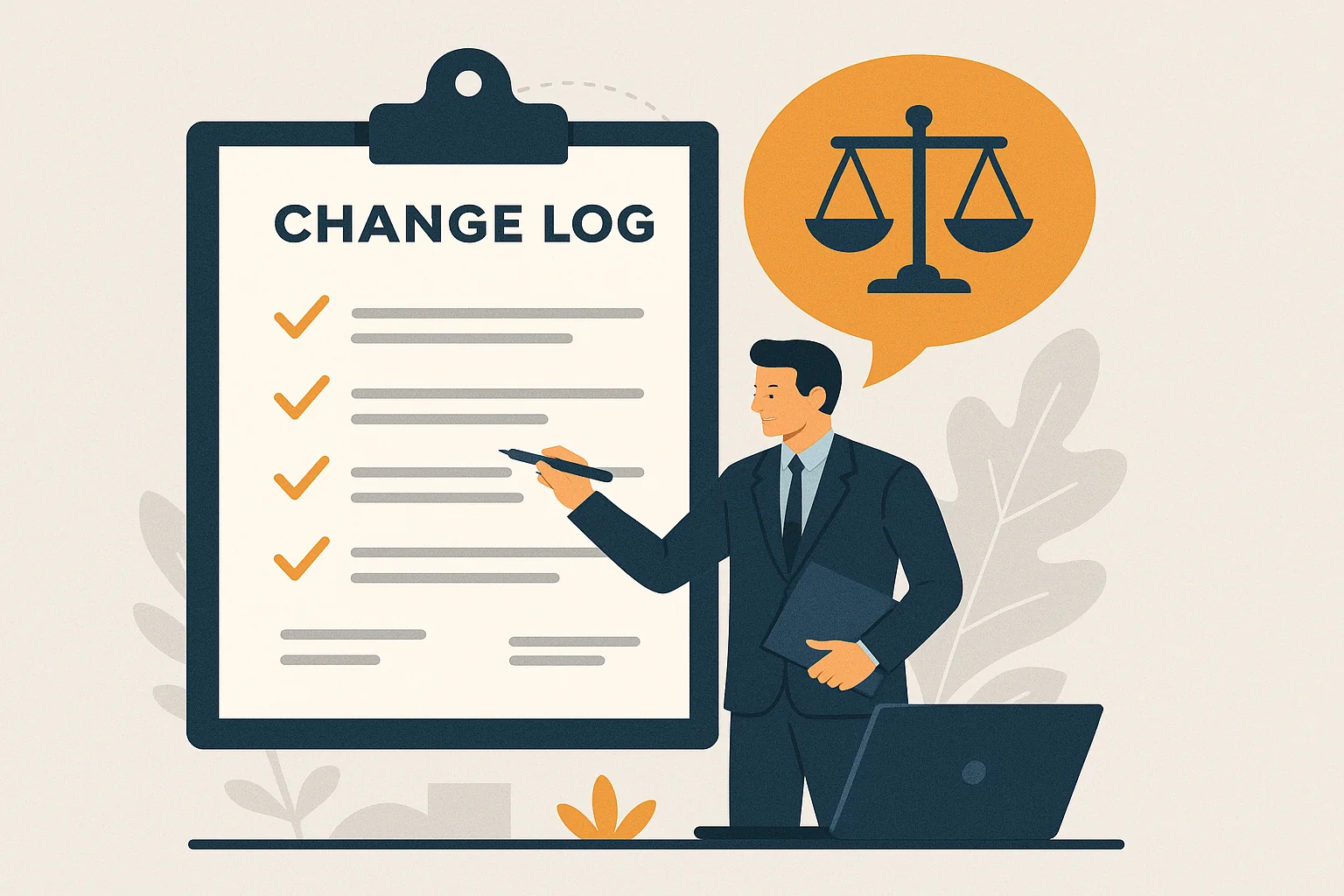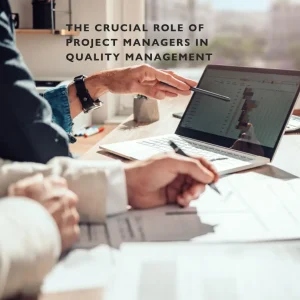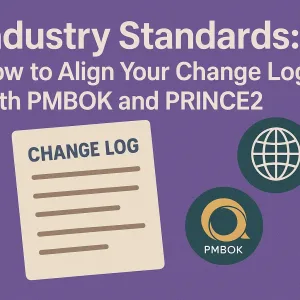Introduction to Change Logs in Project Management
A change log serves as a critical tool for tracking modifications made throughout the project lifecycle. Understanding its definition, significance, and relationship to compliance is essential for project managers and compliance officers alike.
Definition of a Change Log
A change log is a formal record that documents all changes made to a project, including alterations in scope, timelines, resources, and deliverables. It provides a chronological account of modifications, detailing what changes were made, who authorized them, and the reasons behind these adjustments. This documentation is vital for maintaining clarity and accountability within the project team.
Importance of Maintaining a Change Log
Maintaining a change log is crucial for several reasons:
- Risk Management: A well-documented change log helps identify potential risks associated with changes, allowing project managers to mitigate issues before they escalate. By tracking changes, teams can foresee how adjustments may impact project timelines and budgets, thus minimizing disruptions [1].
- Legal Compliance: In many industries, compliance with regulatory requirements is paramount. A change log serves as a legal document that can demonstrate adherence to these regulations. It provides evidence of decision-making processes and can be critical in audits or legal disputes [2].
- Communication and Transparency: Change logs enhance communication among stakeholders by providing a clear record of what has changed and why. This transparency fosters trust and ensures that all parties are informed about the project’s evolution [3].
Overview of How Change Logs Relate to Overall Project Documentation and Compliance
Change logs are an integral part of overall project documentation. They complement other documents such as project plans, status reports, and risk registers by providing a detailed account of changes that may affect these documents.
- Integration with Project Documentation: Change logs should be linked to other project documentation to ensure consistency and accuracy. For instance, when a change is made, it should be reflected in the project plan and communicated to all stakeholders to maintain alignment [4].
- Compliance and Accountability: In the context of compliance, change logs help organizations demonstrate that they are following established protocols and standards. They serve as a record that can be reviewed during compliance checks, ensuring that all changes are justified and documented appropriately [5].
Understanding the legal implications of change logs is essential for project managers and compliance officers. By maintaining a comprehensive change log, teams can enhance their project management practices, ensure compliance with legal requirements, and foster a culture of transparency and accountability.
Legal Importance of Change Logs
Change logs are not merely administrative tools; they hold significant legal implications that every project manager (PM) and compliance officer should understand. Here are the key points regarding the legal importance of change logs:
- Understanding Change Logs as Legal Documents: Change logs are formal records that document all modifications made to a project, including changes to scope, budget, and timelines. These logs serve as legal documents that can be referenced in case of disputes or claims. By maintaining a comprehensive change log, project managers can ensure that all alterations are documented and agreed upon, which can protect the organization in legal scenarios. This documentation is crucial for establishing a clear timeline of events and decisions made throughout the project lifecycle [11][13].
- How Change Logs Can Serve as Evidence in Disputes: In the event of a disagreement between parties, change logs can serve as vital evidence. They provide a chronological account of all changes, approvals, and communications related to those changes. This can be particularly important in legal disputes where the interpretation of contract terms is contested. A well-maintained change log can demonstrate that all parties were informed and agreed to the changes, thereby reducing the risk of liability and supporting the PM’s position in legal proceedings [12][13].
- The Role of Change Logs in Contract Compliance and Regulatory Adherence: Change logs play a critical role in ensuring compliance with contractual obligations and regulatory requirements. They help project managers track changes that may affect compliance with laws, regulations, or contractual terms. By documenting changes and obtaining necessary approvals, PMs can demonstrate adherence to both internal policies and external regulations. This is particularly important in industries that are heavily regulated, where failure to comply can result in significant penalties or legal action [14][15].
Understanding the legal implications of change logs is essential for project managers and compliance officers. By recognizing change logs as legal documents, utilizing them as evidence in disputes, and ensuring they support contract compliance and regulatory adherence, PMs can safeguard their projects and organizations against potential legal challenges.
Common Legal Risks Associated with Poor Change Log Practices
Maintaining a comprehensive and accurate change log is not just a best practice; it is a legal necessity. Inadequate change log management can expose organizations to significant legal risks. Here are some key points to consider:
- Consequences of Incomplete or Inaccurate Change Logs: Incomplete or inaccurate change logs can lead to misunderstandings about project scope, deliverables, and timelines. This can result in disputes between stakeholders, which may escalate to legal action. For instance, if a project manager fails to document a critical change in project specifications, it may lead to claims of breach of contract or negligence if the project does not meet the agreed-upon standards or outcomes. Such disputes can be costly and time-consuming, often resulting in litigation that could have been avoided with proper documentation.
- Examples of Legal Cases Where Change Logs Played a Critical Role: There have been several notable legal cases where the absence or inadequacy of change logs has had significant repercussions. For example, in construction projects, courts have often ruled in favor of clients when contractors could not provide adequate documentation of changes made during the project. In one case, a contractor was held liable for additional costs incurred due to changes that were not properly logged, leading to a judgment that favored the client. These cases underscore the importance of maintaining detailed and accurate change logs to protect against potential legal claims.
- Risks of Non-Compliance with Industry Regulations and Standards: Many industries are governed by strict regulations that require proper documentation of project changes. For example, in the healthcare sector, failure to maintain accurate change logs can lead to violations of compliance standards such as HIPAA or FDA regulations. Non-compliance can result in hefty fines, legal penalties, and damage to an organization’s reputation. Project managers and compliance officers must ensure that change logs are not only complete but also adhere to industry-specific regulations to mitigate these risks.
The legal implications of poor change log practices can be severe, ranging from financial penalties to reputational damage. Project managers and compliance officers must prioritize the maintenance of accurate and comprehensive change logs to safeguard their organizations against these potential legal risks.
Best Practices for Maintaining Effective Change Logs
Maintaining an effective change log is crucial for project managers, especially when considering the legal implications of project documentation. A well-maintained change log not only serves as a record of changes but also protects the project from potential disputes and compliance issues. Here are some actionable strategies for project managers to ensure effective change log management:
Key Elements to Include in a Change Log
- Change Description: Clearly articulate what the change is, including the nature and scope of the modification. This should be detailed enough to provide context for future reference.
- Date of Change: Document the exact date when the change was made. This is essential for tracking the timeline of project modifications and can be critical in legal contexts.
- Reason for Change: Include a brief explanation of why the change was necessary. This helps in understanding the rationale behind decisions and can be important for compliance audits.
- Impact Assessment: Assess and document how the change affects the project’s scope, timeline, and budget. This information is vital for stakeholders and can help in managing expectations.
- Approval Status: Record who approved the change and when. This establishes accountability and can be crucial in legal situations where the legitimacy of changes may be questioned.
- Stakeholder Communication: Note any communications regarding the change with stakeholders. This can serve as evidence of transparency and engagement throughout the project lifecycle.
Establishing a Consistent Format and Process
- Standardized Template: Create a standardized template for change logs to ensure consistency across all projects. This template should include all key elements mentioned above, making it easier for team members to document changes uniformly.
- Regular Updates: Schedule regular intervals for updating the change log, such as after each project meeting or milestone. This ensures that changes are documented in a timely manner and reduces the risk of omissions.
- Version Control: Implement version control for change logs to track revisions over time. This allows project managers to revert to previous versions if necessary and provides a clear history of changes.
Using Technology and Tools
- Project Management Software: Utilize project management tools that offer built-in change log features. These tools can automate the documentation process, making it easier to track changes and maintain records.
- Collaboration Platforms: Leverage collaboration platforms that allow team members to contribute to the change log in real-time. This fosters a culture of transparency and ensures that all relevant changes are captured promptly.
- Cloud Storage: Store change logs in a secure cloud environment to ensure accessibility and protection against data loss. This also facilitates easy sharing with stakeholders and compliance officers when needed.
By implementing these best practices, project managers can maintain effective change logs that not only serve as a record of project modifications but also protect the project from legal implications and compliance issues. A well-documented change log is an invaluable asset in navigating the complexities of project management.
Integrating Change Logs into Project Documentation
Change logs play a crucial role in maintaining the integrity and transparency of project documentation. Understanding their legal implications is essential for project managers and compliance officers alike. Here are some key points to consider regarding the integration of change logs into the broader project documentation framework:
- Role of Change Logs in Project Documentation: Change logs serve as a systematic record of all modifications made to project documents, including updates, revisions, and amendments. They are essential for tracking changes that impact the project’s baseline, ensuring that all stakeholders are aware of the current status and history of the project. This documentation is vital not only for project success but also for legal compliance, as it provides a clear audit trail of decisions and changes made throughout the project lifecycle [1][9].
- Collaboration Between Project Managers and Compliance Officers: Effective integration of change logs requires collaboration between project managers and compliance officers. Project managers must ensure that change logs are not only maintained but also aligned with compliance requirements. This collaboration helps in identifying potential legal risks associated with changes and ensures that all modifications are documented in a manner that meets regulatory standards. By working together, these professionals can create a robust framework that supports both project objectives and legal obligations [3][4].
- Accessibility and Regular Updates: For change logs to be effective, they must be easily accessible to all relevant stakeholders and regularly updated. This accessibility ensures that team members are using the most current information, which helps to avoid confusion and errors that could lead to legal complications. Regular updates to change logs also demonstrate due diligence and accountability, which are critical in the event of disputes or audits. Establishing a clear version control system for all project documents, including change logs, is essential for maintaining clarity and compliance [2][6].
Integrating change logs into the project documentation framework is not just a best practice; it is a legal necessity. By understanding their importance and ensuring collaboration between project managers and compliance officers, organizations can mitigate risks and enhance the overall success of their projects.
Success and Failure in Change Log Management
Maintaining a comprehensive change log is not just a best practice; it can also be a critical legal safeguard. This section explores two examples that highlight the importance of effective change log management, illustrating both the benefits of diligent documentation and the pitfalls of neglect.
Successful Change Log Utilization
Project Overview:
A large-scale construction project for a municipal infrastructure upgrade was undertaken by a reputable contractor. The project involved multiple stakeholders, including government agencies, subcontractors, and community representatives.
Change Log Management:
The project manager implemented a robust change log system from the outset. This included:
– Detailed Documentation: Every change request was logged with comprehensive details, including the nature of the change, reasons for the change, and the parties involved.
– Regular Updates: The change log was updated in real-time and reviewed during weekly project meetings, ensuring all stakeholders were informed.
– Legal Review: Significant changes were reviewed by legal counsel to assess potential impacts on contracts and compliance.
Outcome:
When a dispute arose regarding project delays attributed to unforeseen changes, the well-maintained change log served as a critical piece of evidence. It demonstrated that all changes were documented, communicated, and approved by relevant parties. This transparency helped mitigate legal risks, leading to a favorable resolution without litigation. The project was completed on time and within budget, showcasing the effectiveness of diligent change log management.
Legal Challenges Due to Poor Change Log Practices
Project Overview:
In contrast, a software development project for a financial services firm faced significant challenges due to inadequate change log practices. The project involved developing a new application with strict regulatory compliance requirements.
Change Log Management:
The project manager failed to establish a formal change log process, resulting in:
– Inconsistent Documentation: Changes were often communicated verbally or via informal emails, leading to confusion about what modifications had been made.
– Lack of Stakeholder Engagement: Key stakeholders were not consistently informed about changes, resulting in misalignment on project goals.
– No Legal Oversight: Changes that could have legal implications were not reviewed by legal counsel, increasing the risk of non-compliance.
Outcome:
As the project progressed, the lack of a formal change log became problematic. When regulatory auditors reviewed the project, they identified several undocumented changes that violated compliance standards. This oversight led to significant legal repercussions, including fines and mandated project revisions. Ultimately, the project was delayed by several months, incurring additional costs and damaging the firm’s reputation.
Lessons Learned
Several key lessons emerge regarding change log management:
- Documentation is Essential: A well-maintained change log is crucial for tracking project modifications and ensuring compliance with legal and regulatory requirements.
- Stakeholder Communication: Regular updates and stakeholder engagement are vital to maintain alignment and transparency throughout the project lifecycle.
- Legal Oversight: Involving legal counsel in the change management process can help identify potential risks and ensure that all changes comply with contractual obligations and regulations.
The contrasting outcomes of these examples underscore the importance of effective change log management in project management. By learning from both successes and failures, project managers and compliance officers can better navigate the legal implications of change logs, ultimately leading to more successful project outcomes.
Conclusion: The Essential Role of Change Logs in Project Management
Maintaining thorough change logs is not merely a best practice; it is a legal necessity that can have significant implications for the success and integrity of a project. Here are the key points to consider regarding the legal significance of change logs:
- Legal Significance: Change logs serve as a formal record of all modifications made throughout the project lifecycle. They document decisions, approvals, and the rationale behind changes, which can be crucial in legal disputes or audits. A well-maintained change log can provide evidence that due diligence was exercised, thereby protecting the organization from potential legal ramifications arising from non-compliance or miscommunication [10][15].
- Prioritizing Change Log Management: Project managers are encouraged to prioritize the management of change logs as an integral part of their project documentation. By doing so, they not only enhance project transparency and accountability but also mitigate risks associated with project changes. This proactive approach can lead to smoother project execution and a clearer understanding of project evolution among stakeholders [11][12].
- Collaboration with Compliance Officers: It is essential for compliance officers to collaborate closely with project managers to ensure that change logs are comprehensive and adhere to regulatory requirements. This partnership can facilitate the development of standardized processes for documenting changes, which can ultimately lead to improved compliance and reduced risk of legal issues. By working together, project managers and compliance officers can create a robust framework that supports both project success and legal adherence [13][14].
Understanding the legal implications of change logs is vital for project managers and compliance officers alike. By recognizing their importance and committing to effective change log management, organizations can safeguard their projects against legal challenges while fostering a culture of accountability and transparency.
Find out more about Shaun Stoltz https://www.shaunstoltz.com/about/.
This post was written by an AI and reviewed/edited by a human.



